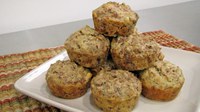Prairie Fare: Try a Fruit With Appeal
(Click the image below to view a high-resolution image that can be downloaded)
By Julie Garden-Robinson, Food and Nutrition Specialist
NDSU Extension Service
I noticed a very ripe banana on the dresser. I had not put a banana on my dresser, but I got the hint.
“I could smell that banana from the hallway,” my husband said.
I had been unpacking my suitcase after a trip out of state, and I had not unpacked the conference bag we all received. As I left the hotel, I picked up a snack and put it in my conference bag.
The banana was now past the “banana bread” phase.
I seem to have a habit of forgetting snacks in my bags. One time, I left an orange in the side pocket of my canvas briefcase. I was wondering why one of our dogs kept sniffing my bag.
I think I need to have my sense of smell tested or try a decongestant. Unlike bananas, I can’t think of any use for fermenting oranges.
Bananas and other fruits are tasty snacks but, of course, are perishable. In fact, peeled and cut fruit are highly perishable and should be kept cold if you have a buffet line this summer for gatherings of family and friends. Just like any other perishable food, sliced fruit should spend no more than two hours at room temperature.
Bananas often are a bargain in grocery stores, compared with other types of fresh fruit, depending on the time of year. Do you pick up a few to slice on your cereal or use in bread or muffin recipes?
Bananas have been a popular fruit for thousands of years. In early times, bananas were held in such high esteem they became known as the ""fruit of the wise man"" and ""fruit of paradise."
When people think of the nutritional properties of bananas, potassium comes to mind. Potassium plays important roles in fluid balance, nerve transmission and muscle contraction. Bananas also are a good source of carbohydrate and B vitamins, with just a trace of fat.
There's some evidence bananas were the first plants cultivated by humans. They're a portable snack that makes our quest for eating enough fruits a little easier. Most adults need about 1 1/2 cups of fruit to meet the current recommendations.
As shoppers know, bananas arrive from their tropical origins looking very green. Actually, their green hue is a benefit to consumers because flavor decreases as bananas ripen on the tree. Although banana skins darken in the refrigerator, the cool temperature actually helps preserve the flavor and texture of the fruit.
Of the 300 or more varieties of bananas, the yellow, smooth-skinned type is most familiar to us. The red banana, which is uncommon in many grocery stores, actually has a similar flavor and texture. Another cousin, the plantain, is eaten as a cooked vegetable.
Here’s a bit of trivia for you. Technically, one banana is known as a “finger” and a group of bananas is known as a “hand.”
A pound of bananas yields 2 cups of sliced bananas or 1 1/2 cups mashed.
In season, bananas are very economical. If you have a few bananas in need of a recipe, here’s a tasty one that also helps you use up some breakfast cereal that might be in your cupboard. Bran cereal is an excellent source of insoluble fiber that helps you feel full and also keeps you stay “regular.”
Banana Bran Muffins
1/2 c. butter, softened
2/3 c. sugar
2 eggs
3 medium ripe bananas, mashed
1/2 c. buttermilk
1 1/2 c. all-purpose flour
1 1/2 tsp. baking soda
1/2 tsp. salt
4 c. bran cereal or raisin bran cereal
1/2 c. chopped pecans (optional)
Preheat oven to 350 F. In a large bowl, cream butter and sugar together. Add the eggs, bananas and buttermilk. Combine the flour, baking soda and salt; stir into creamed mixture just until moistened. Fold in the cereal and pecans, if desired. Batter will be chunky from the cereal. Fill greased muffin cups. Bake at 350 F for 25 to 30 minutes or until a toothpick comes out clean. Cool for five minutes before removing from pans to wire racks. Serve warm.
Makes 14 servings. Each serving has 230 calories, 10 grams (g) of fat, 5 g of protein, 32 g of carbohydrate, 3 g of fiber and 320 milligrams of sodium.
(Julie Garden-Robinson, Ph.D., R.D., L.R.D., is a North Dakota State University Extension Service food and nutrition specialist and professor in the Department of Health, Nutrition and Exercise Sciences.)
NDSU Agriculture Communication – May 14, 2015
| Source: | Julie Garden-Robinson, (701) 231-7187, julie.garden-robinson@ndsu.edu |
|---|---|
| Editor: | Rich Mattern, (701) 231-6136, richard.mattern@ndsu.edu |


